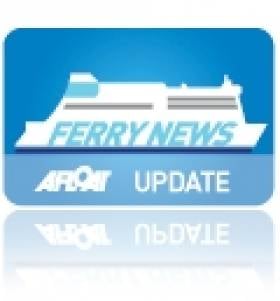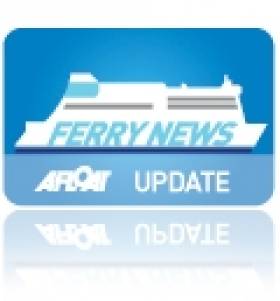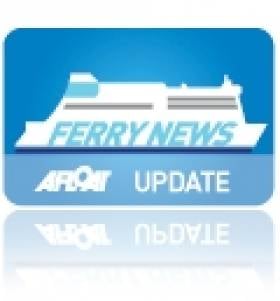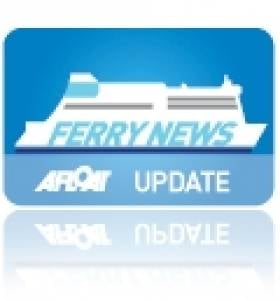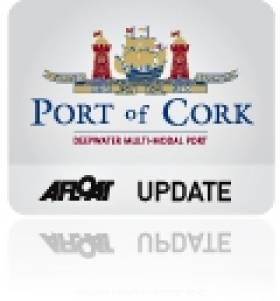Displaying items by tag: Brittany Ferries
Brittany Ferries End of Season Sailings
Pont-Aven's final end of season sailing will be departing Ringaskiddy on Saturday (29th) at 15.00hrs and she is due to arrive at her homeport of Roscoff at 06.00hrs local time.
To confirm sailing schedule including next season starting March 2012 click HERE and for sailing update click HERE.
The €100m luxurious ferry was built in Germany in 2004 and she entered service that year on the three-route roster linking Ireland on the 14-hour overnight weekend sailings in addition to serving on French-UK and UK-Spainish routes.
Uniquely she is the only ferry operating in Irish waters with a swimming pool which is enclosed on the upper deck. Of the various facilities, services and entertainment, they may vary depending on the date and time of year.
Wexford Welcomes New Irish-French Ferry Celtic Horizon
The changeover of vessels coincides with the existing Rosslare-Cherbourg sailing schedule of three round-trips per week, noting there are no sailings from the Wexford port on Mondays. Celtic Horizon is due to be introduced with her maiden 'Irish' voyage on Tuesday night, departing Rosslare at 21.30hrs. On the following Monday she is to be officially launched onto the service.
Celtic Horizon will boost capacity on the French route, offering a wider choice of restaurants, bars and a children's play-room. She can carry 840 passengers, 200 cars and 120 freight vehicles. The 186m ferry is from a ro-pax series (including Norman Voyager) designed and built by Cantiere Navala Visentini based in Portoviro, outside Venice.
During her five-day repositioning route from the Mediterranean, Celtic Horizon made an en-route call to Gibralter, anchoring off the British colony on Thursday. Another of the same Visentini ro-pax class vessels, Cartour Epilson is believed to have taken over Celtic Horizon, formerly named Cartour Beta when she served her last season between Termini Imerese in Sicily to Salerno while on charter to C&T.
CLF will be the only ferry operator running services to France, between 2 January -19 February 2012, as Irish Ferries, which also operates on the Rosslare-Cherbourg route, will be taking off Oscar Wilde for annual dry-docking. For schedules click HERE.
In addition there will be no sailings between Cork-Roscoff, as Brittany Ferries final sailing for this year is 29 October, served by 'flagship' Pont-Aven. The 2012 season starts in late March.
New Celtic Link Ferry on Re-Positioning Voyage off Africa
CLF are to charter Celtic Horizon for a five-years and the 25-knot capable vessel will takeover the existing thrice-weekly round trip sailing schedule from ro-pax Norman Voyager. Between 2 January -19 February 2012, CLF will be the only continental ferry operator running services as rivals Irish Ferries will be taking their cruiseferry Oscar Wilde for annual dry-docking. To read more click HERE.
In addition there will be no sailings between Cork-Roscoff, as operators Brittany Ferries last sailing for this year is 29 October, served by 'flagship' Pont-Aven. The 2012 season starts in late March.
Celtic Horizon is the first vessel to be named with a 'Celtic' prefix of part of their ferry operations, since the company brought European Diplomat from former route operators P&O (Irish Sea) in 2005. The freight-ferry renamed Diplomat, served Celtic Link Ferries until 2009. Since then she has been on charter in the Caribbean until this summer when she was sold to the breakers in Alang, India. To read more click HERE.
As for Celtic Horizon, she was built in 2006 and spent her last season this year as Cartour Beta while on charter to C&T's routes between Naples and Sicily, to read more click HERE. The 186m ro-pax is believed to be heading for Gibraltar while en-route to Rosslare.
During her Irish service, she will maintain Italian registry of Bari whereas her predecessor Norman Voyager changes flags from the UK to that of the French tricolour. Both vessels are similar as they share a ro-pax design which has proved popular for Italian shipbuilders Cantieri Navali Visentini.
The 2008 built Norman Voyager of 26,904grt is to revert to LD Lines operation and used on their 'Motorways of the Seas' St. Nazaire-Gijon service, though she was to enter on the Marseilles-Tunis route. Her new role on the Franco-Iberian route sees the replacement of Norman Asturias.
Seasonal Services Set Sail ‘Four’ France
Also operating on the same route to Normandy are Celtic Link Ferries which run the modern sleek Italian built 800 passenger /200 vehicle ro-pax ferry Norman Voyager. Short wine breaks are from €200 return for a car, driver and a two-berth outside cabin. Additional passengers can travel for €10 each way and subject to sailing schedules passengers can stay in Cherbourg for up to five hours.
A third operator to France is Brittany Ferries which sails on the Cork-Roscoff route and which is served by their 'flagship' Pont-Aven. The €100m ferry has a swimming pool and this is unique to any route operating out of Ireland. The company are offering one-way fares from €70 per person based on a car with four adults in an inside cabin.
Sailings depart Saturday's from Cork and arrive in the Breton port 14 hours later, making the route the shortest and fastest of the four continental services.
Brittany Ferries Roscoff Route to Re-open
The German built 41,700grt vessel stays at the port for an 8 -hour turn-around before making the seasons inaugural outbound sailing to France at 16.00hrs.
Pont-Aven can arguably claim to be the most luxurious 'cruiseferry' operating to Ireland as the vessel has a small number of luxury cabins incorporating balconies and uniquely to feature a swimming pool.
The swimming pool and leisure area can be covered over by a retractable roof. The option of the 'open-air' swimming pool may prove more popular with her 2,400 passengers as the cruiseferry also operates on a triangular route roster between Roscoff-Plymouth and Plymouth-Santander
Pont-Aven also operates a second Spanish route, Santander-Portsmouth in tandem with Cap Finistère. The 32,728grt cruiseferry last week opened a new route for Brittany Ferries also from Portsmouth to Bilbao, for details click here.
The Bibao route had closed in September when P&O Ferries withdrew from the service which since 1993 has been run by Pride of Bilbao. The 37,583grt was on charter from the Irish Continental Group (ICG) the parent company of Irish Ferries until its sale late last year to a Baltic Sea ferry operator between Helsinki-(Tallinn)-St.Petersburg, for more information click here.
Brittany Ferries Re-Open Bilbao Route
The Cap Finistere has a 790 passenger / 500 vehicle capacity and the vessel will operate two round trips weekly with each crossing taking 24 hours. Interestingly an additional en-route call to Roscoff is scheduled on Sunday sailings bound for Bilbao which will take 33-hours. This is to facilitate a crew change, as the Cap Finistere does not operate on any of the company routes from France.
In 2009 the P&O service carried 180,000 passengers and 193,000 in 2008 but closed due to "unsustainable losses". There were 800 redundancies but some 150 staff jobs were secured through transfer. Click here for a previous posting. The company were in direct competition with Brittany Ferries existing two routes between Plymouth and Poole to Santander.
The Bilbao route brings the Brittany Ferries operations to five sailings weekly between the UK to Spain, two from Portsmouth to Santander and a single round-trip to Plymouth.
The Pride of Bilbao was sold late last year by ICG to the Baltic Sea based St. Peter Line at a profit of €9.4m. The vessel underwent refurbishment and was renamed Princess Anastasia and next month starts a new St. Petersburg-Stockholm service, with Russian bound sailings calling en route to
the Estonian capital of Tallinn. Click here for more details.
Pride of Bilbao's return to the Baltic is nearly full-circle as the 2,553 passenger / 600 vehicles vessel, built in 1986 as Olympia for Viking Line's also operated out of Stockholm to Helsinki, and at the time was one of the largest overnight passenger capacity ferries in the world.
‘Proposed’ Cork-Spain Route Remains Under Review
In addition to services running out of Rosslare operated by Celtic Link Ferries and Irish Ferries and the alternative option of landbridge connections to Europe via the UK.
In the meantime, the Port of Cork will continue to be in dialogue with potential operators and investor's, however in the current climate it is proving more challenging to establish the service. Yet both the port authorities in Cork and Gijon remain committed in establishing the first direct Irish-Iberia passenger ferry route, with an update on the Spanish service due in early June.
Since 2008 the port authorities of Cork and Gijón, through the Promotion of Short Sea Shipping and Co-Operation with Small Medium Enterprise's (Proppose) an EU Inter-Reg project, have conducted feasibility studies into the service.
Interest in the service to date, has shown interest from Brittany Ferries, P&O Ferries and Transfennica, a Scandinavian based operator. It was envisaged that a ro-pax type of vessel would operate the 24-hour route to Gijón in Asturias, the region which forms part of Spain's northern 'Green' coast.
The route across the Bay of Biscay would be an attraction to freight hauliers, saving mileage and reduced fuel costs in addition avoiding a weekend ban to trucks travelling through France.
Last summer the ro-pax Norman Bridge started a new route between Nantes / St. Nazaire (Montoir-de-Bretagne) and Gijón, operated by GLD Atlantique. This route received support through the EU 'Motorways of the Seas' (MOS) programme to divert vehicle traffic from congested road-infrastructure and transferred to designated shipping routes, using larger and faster ro-pax vessels.
The route's opening was marked with a declaration signed by Dominique Bussereau, the French Minister of State responsible for Transport and his Spanish counterpart Magdalena Alvarez of the first of two Franco-Spanish MOS concept routes, starting with the 14-hour GLD Atlantique service.
- Irish Ferries
- port of Cork
- Celtic Link Ferries
- Fastnet Line
- P&O Ferries
- Brittany Ferries
- Ports and Shipping News
- Cork Harbour News
- RoPax
- Port of Gijón
- Proppose
- Motorways of the Seas
- MOS
- Transfennica
- CorkGijón
- Asturias
- 'Green'Spain
- Landbridge
- NantesSt.Nazaire
- GLD Atlantique
- Norman Bridge
- Cork Harbour
Port of Cork Traffic Up 10% in 2010
While all sectors at the Port of Cork experienced a challenging period during 2010, the end of year total trade traffic shows an increase. Total trade in 2010 through the Port of Cork amounted to 8.8 million tonnes, an increase of 8.6% compared to 2009.
One area of increase which has a very positive effect on the local economy is the increase in exports from the Port. Total exports at the Port of Cork have remained strong increasing by 10% to date, in comparison to 2009. Exports are a key driver in the successful recovery of the Irish Economy and the Port of Cork is committed to continuous support in the growth of international trade for both current and future economic prospects.
The container business at the Port of Cork has remained constant with over 150,000 TEU handled in 2010. Animal feed stuffs, fertiliser and other trades have shown a significant increase in 2010. Oil traffic has shown a slight increase of 3.5% as a consequence of lower levels of economic activity; however it continues to be a significant part of the Port of Cork business.
Commenting on the end of year trade traffic results, Mr Dermot O'Mahoney Chairman of the Port of Cork said: "The Port of Cork is pleased to announce that total trade traffic in 2010 has shown an 8.6 % increase on 2009 traffic. With 98% of all goods imported or exported from Ireland moved by ship, the importance of ports to our economy is vital. The Port of Cork is a key link to the continued economic success of the entire Munster region and the challenges now for the Port of Cork, is to continue to develop. This requires that we be visionary and seize opportunities presented by emerging trends and logistic supply changes."
He continued: "While the next four to five years will be challenging for us all, we need to continue to promote the fact that Ireland is an excellent investment location and is well placed to capitalise on growing global markets."
52 cruise liners visited the Port of Cork during 2010 bringing over 100,000 passengers and crew to the region. According to research carried out by UK consultants GP Wild, the average in-transit spend per passenger, while visiting an Irish port is €73. This is a significant contribution towards the local tourism economy.
Ferry passenger numbers though the port also increased mainly due to the welcomed re-commencement of the ferry service linking Cork with Swansea. The weekly ferry service from Cork to Roscoff with Brittany Ferries also had a successful year.
In 2010, the Port of Cork developed a recreational strategy to improve the marine leisure facilities around Cork Harbour. The first project carried out was the construction of a 100m marina on South Custom House Quay. This long term investment for the city of Cork has already proven to be very popular among local boats and visiting boats. The Port of Cork expects 2011 to be even busier.
Bilbao Returns to Baltic Sea 'Roots'
For the last 17 years the Pride of Bilbao has operated between Portsmouth and Bilbao under charter to P&O. Built in 1986, she was launched as Olympia for Viking Line between Stockholm and Helsinki, then the Baltic Sea ferry was one of the largest overnight passenger capacity ferries in the world. At 177 metres long the vessel can accommodate 2552-passengers, 600-vehicles and space for 77-trucks. She has a sister, the Mariella, which currently operates on Viking Line's Stockholm-Mariehamn–Helsinki service.
In 1993 the vessel was renamed Pride of Bilbao and launched a new service on the Bay of Biscay, under charter from her Scandinavian owners. The following year ICG purchased the Pride of Bilbao from Viking Line and she was re-registered to the Bahamas. The vessel was subsequently entered into a British bare-boat charter arrangement between P&O Ferries and ICG. Due to unsustainable losses the route closed on 28 September this year but rivals Brittany Ferries soon shortly announced they would reopen the route in Spring 2011.
Throughout the Pride of Bilbao's career under ICG (parent company of Irish Ferries), the cruiseferry has only once visited Ireland. In between Spanish sailings, she was sub-chartered for a three-day Christmas mini-cruise from Portsmouth to Dublin in 2004, where the Pride of Bilbao berthed at the ferryport close to the ICG headquarters.
Winter's French 'Ferry' Connections
Direct continental ferry services between Ireland and France will be reduced as of this weekend, writes Jehan Ashmore.
Brittany Ferries last sailing for this year on the Cork-Roscoff route ends today. The 11-hour route is normally served by 'flagship' Pont-Aven but this weekend's final round-trip will be operated by the Bretagne. The former flagship, built in 1989 had served on the Irish route for several years but now operates St.Malo-Portsmouth sailings. Cork-Roscoff sailings resume in 2011 with the first crossing from the Breton port on 1 April 2011 and the corresponding departure from Ireland on 2 April.
In the interim period, alternative routes to France are maintained by Irish Ferries and Celtic Link Ferries. On the Rosslare-Cherbourg route, operated by Irish Ferries, sailings are scheduled to run to 31 December but there will be no sailings throughout January 2011 and up to mid-February. This is to allow the routes cruiseferry Oscar Wilde to undergo annual dry-docking before re-opening the route on 16 February. In addition Irish Ferries operate the seasonal Rosslare-Roscoff route which starts on 13 May.
Celtic Link Ferries also operate on the Rosslare-Cherbourg route. During January 2011, the company will be the only ferry operator providing services between Ireland and France.

Celtic Link Ferries ro-pax Norman Voyager
The 17-hour route to Cherbourg is served by the 2008-built ro-pax Norman Voyager, the newest vessel on the continental routes. Norman Voyager accommodates 800 passengers, 200 cars and up to 120 freight vehicles. There are 110 cabins and facilities for passengers include a bar, restaurant, lounges, cinema and a shop.




























